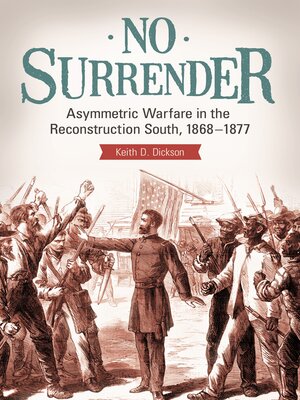
Sign up to save your library
With an OverDrive account, you can save your favorite libraries for at-a-glance information about availability. Find out more about OverDrive accounts.
Find this title in Libby, the library reading app by OverDrive.



Search for a digital library with this title
Title found at these libraries:
| Library Name | Distance |
|---|---|
| Loading... |
A modern and current examination of Reconstruction that explains how the South in the aftermath of defeat in a total war, was still able to exhaust the will of the powerful North using asymmetric warfare.
The end of the Civil War may have marked the end of the official fighting, but the Congressional strategy to remake the South during Reconstruction led to a new period of warfare—asymmetric warfare in which the defeated Confederacy became the Southern resistance. Despite all the power at its disposal, the North failed to change the South after nearly 11 years of effort and instead accepted a political-social equilibrium dictated by the South. This book presents Reconstruction through an unconventional lens to explain the process of transition from war to warfare, and finally to equilibrium represented by the emergence of the New South.
Author Keith D. Dickson explains how Reconstruction created a false equilibrium in the immediate aftermath of the Civil War and was reversed by Congressional action that imposed a new social and political order. By resistance of these actions through asymmetric warfare, the white South was able to establish a new equilibrium—one dictated by the South that opened the path to the New South.
Providing insights from an author who is both a respected academic military historian as well as a former practitioner of unconventional warfare as a Special Forces officer, the book covers the historical period 1865–1877, casting the Reconstruction period as an example of protracted asymmetric warfare. This asymmetric warfare was conducted in phases against the Republican state governments. As both the U.S. Congress and the Grant administration abandoned the lofty goals for Reconstruction, a bitterly contested presidential election provided the opportunity to establish conditions favorable to the white South that would in turn lead to a political-social equilibrium that allowed reconciliation to begin.
The end of the Civil War may have marked the end of the official fighting, but the Congressional strategy to remake the South during Reconstruction led to a new period of warfare—asymmetric warfare in which the defeated Confederacy became the Southern resistance. Despite all the power at its disposal, the North failed to change the South after nearly 11 years of effort and instead accepted a political-social equilibrium dictated by the South. This book presents Reconstruction through an unconventional lens to explain the process of transition from war to warfare, and finally to equilibrium represented by the emergence of the New South.
Author Keith D. Dickson explains how Reconstruction created a false equilibrium in the immediate aftermath of the Civil War and was reversed by Congressional action that imposed a new social and political order. By resistance of these actions through asymmetric warfare, the white South was able to establish a new equilibrium—one dictated by the South that opened the path to the New South.
Providing insights from an author who is both a respected academic military historian as well as a former practitioner of unconventional warfare as a Special Forces officer, the book covers the historical period 1865–1877, casting the Reconstruction period as an example of protracted asymmetric warfare. This asymmetric warfare was conducted in phases against the Republican state governments. As both the U.S. Congress and the Grant administration abandoned the lofty goals for Reconstruction, a bitterly contested presidential election provided the opportunity to establish conditions favorable to the white South that would in turn lead to a political-social equilibrium that allowed reconciliation to begin.







